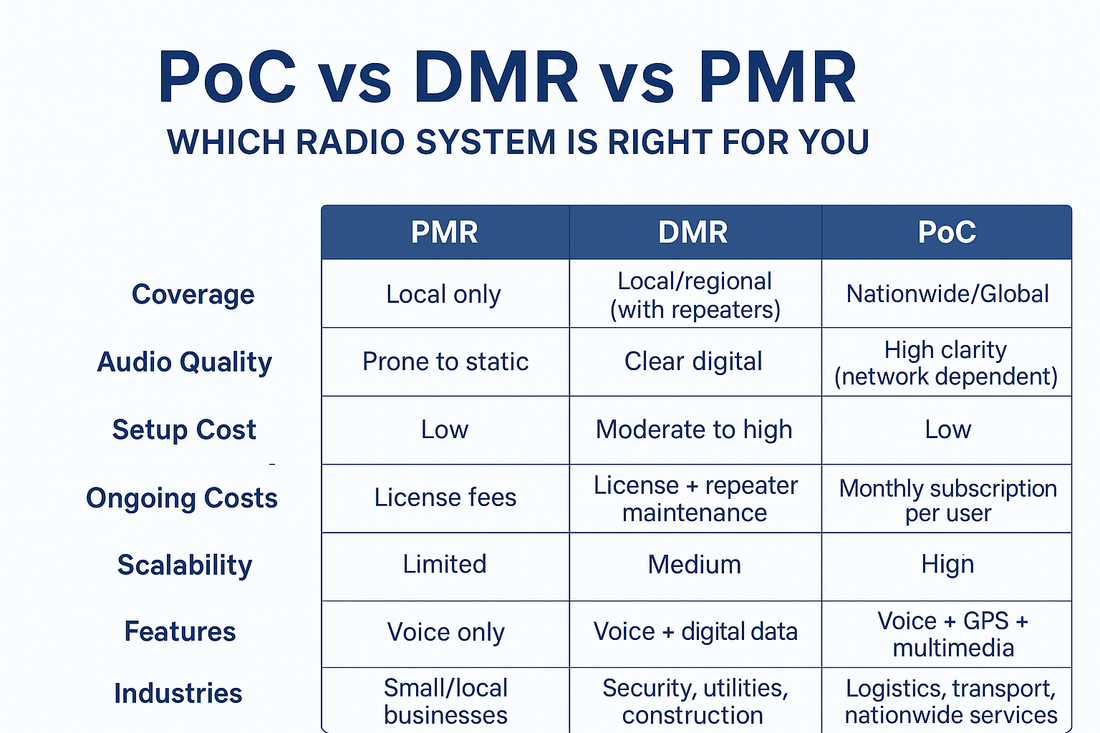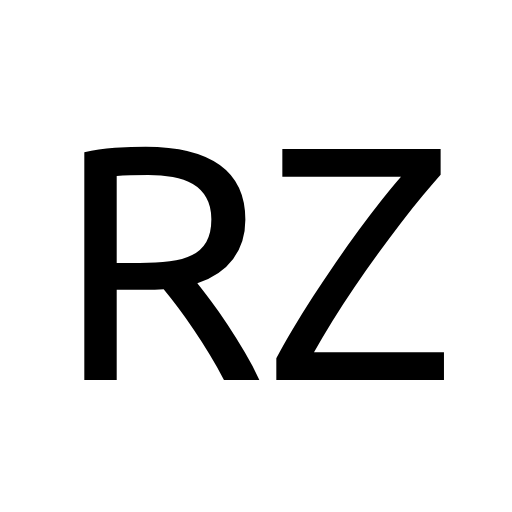
PoC vs DMR vs PMR: Which Radio System is Right for You?
Share
Introduction: The Evolution of Radio Communication
In the world of mission-critical and business communication, choosing the right radio system is no longer a straightforward decision. For decades, analog radios and PMR (Private Mobile Radio) systems were the standard for industries like security, construction, and transport. Later, DMR (Digital Mobile Radio) modernized the space with digital clarity, longer battery life, and advanced features.
But today, Push-to-Talk over Cellular (PoC) radios are changing the game. Instead of relying solely on radio frequencies, they leverage mobile networks (4G, 5G, and Wi-Fi) to deliver nationwide—and even global—coverage.
So which is best for your business? PoC, DMR, or PMR? This guide breaks down the pros, cons, and real-world use cases to help you make the most cost-effective and future-proof choice.
What is PMR? (Private Mobile Radio)
PMR refers to traditional analog radio systems used in industries that require reliable short-range communication. They operate on dedicated frequencies (often licensed) and remain popular in specific sectors.
✅ Advantages of PMR:
- Simple, proven, and easy to use.
- Works without internet or cellular coverage.
- No ongoing subscription fees (once licensed).
- Rugged, durable hardware.
❌ Disadvantages of PMR:
- Limited range (typically 2–5 km in urban settings).
- Signal interference and static.
- Minimal advanced features compared to digital systems.
- Requires frequency licenses in most regions.
Best for:
- Small teams working in local areas (warehouses, construction sites, event management).
- Organizations with tight budgets and no need for wide-area communication.
What is DMR? (Digital Mobile Radio)
DMR is the digital evolution of PMR, providing clearer audio, longer battery life, and data capabilities. It uses time-division technology to double the capacity of a channel, making it more efficient.
✅ Advantages of DMR:
- Crystal-clear digital voice quality.
- Longer battery life compared to analog PMR.
- Scalable for medium to large organizations.
- Enhanced security with digital encryption.
- Works with existing radio infrastructure.
❌ Disadvantages of DMR:
- Requires repeaters for extended coverage.
- Initial infrastructure costs can be high.
- Still limited by geography compared to PoC.
- Not as flexible as cellular-based solutions.
Best for:
- Security, utilities, and transport companies needing better clarity and moderate coverage.
- Businesses wanting to upgrade from PMR without fully relying on mobile networks.
What is PoC? (Push-to-Talk Over Cellular)
PoC radios use cellular networks (4G, 5G) and Wi-Fi to provide instant voice communication. Unlike PMR and DMR, they are not limited by distance—if there’s network coverage, the radios can connect.
✅ Advantages of PoC:
- Nationwide or global coverage via mobile networks.
- No need for repeaters or radio towers.
- Lower upfront infrastructure costs.
- Advanced features like GPS tracking, multimedia messaging, and lone-worker safety.
- Ideal for companies with mobile workforces.
❌ Disadvantages of PoC:
- Requires SIM card and subscription fees.
- Coverage dependent on mobile network availability.
- May require rugged devices for extreme conditions.
Best for:
- Logistics, transportation, security, and field services with teams across cities or countries.
- Businesses needing advanced monitoring and dispatch features.
Side-by-Side Comparison: PoC vs DMR vs PMR
| Feature / Factor | PMR (Analog) | DMR (Digital) | PoC (Cellular) |
|---|---|---|---|
| Coverage | Local only | Local/regional (with repeaters) | Nationwide/Global |
| Audio Quality | Prone to static | Clear digital | High clarity (network dependent) |
| Setup Cost | Low (basic radios) | Moderate to high | Low (no towers needed) |
| Ongoing Costs | License fees | License + repeater maintenance | Monthly subscription per user |
| Scalability | Limited | Medium | High (easy to add users) |
| Features | Voice only | Voice + digital data | Voice + GPS + multimedia |
| Industries | Small/local businesses | Security, utilities, construction | Logistics, transport, nationwide services |
Cost Considerations: Which is Most Affordable in the Long Run?
PMR Costs
- Devices: $80–$300 each.
- Licensing: $50–$200 annually depending on jurisdiction.
- Ongoing Costs: Minimal.
DMR Costs
- Devices: $200–$800 each.
- Repeaters: $2,000–$10,000 (depending on setup).
- Licensing: Required.
- Ongoing Costs: Maintenance + license renewal.
PoC Costs
- Devices: $150–$1,200 each.
- Subscription: $15–$40 per user/month.
- Ongoing Costs: Subscription + optional extras (dispatch software, GPS tracking).
👉 If you’re running a small local team, PMR or DMR may be cost-effective. But for scalable, long-distance operations, PoC is typically cheaper long term since it avoids expensive repeater setups.
Industry Use Cases
1. Security Companies
- PMR: Small venue/event security.
- DMR: Larger sites with multiple teams.
- PoC: Nationwide security firms with centralized dispatch.
2. Logistics & Transportation
- PMR: Not practical beyond depots.
- DMR: Fleet management within cities.
- PoC: Long-haul trucking, ride-hailing, delivery services.
3. Construction & Utilities
- PMR: Ideal for single-site projects.
- DMR: Multi-site projects with repeater support.
- PoC: Large infrastructure projects requiring wide-area coverage.
4. Emergency Services
- PMR: Backup/local use.
- DMR: Good for municipal response teams.
- PoC: Useful for coordination across multiple regions.
Future-Proofing: Where Is the Industry Headed?
The arrival of 5G is making PoC radios more attractive, as they can handle not only voice but also real-time video, instant data, and AI-based monitoring. Many organizations are already shifting budgets toward PoC solutions, especially those operating across regions.
That said, PMR and DMR are not disappearing—they remain essential in areas with no cellular coverage or where independent networks are a requirement. Hybrid solutions (DMR + PoC) are also on the rise.
Choosing the Right System: Key Questions to Ask
-
Where does my team operate?
- Local vs nationwide vs international.
- What’s my budget for upfront costs vs ongoing costs?
- Do I need advanced features (GPS, lone worker alerts, multimedia)?
- Is network coverage reliable in my operating areas?
- Do I need a system that scales easily with business growth?
Conclusion: Making the Smart Choice
- Choose PMR if you’re a small, local team with basic communication needs.
- Choose DMR if you want better clarity, digital security, and moderate expansion without jumping to cellular.
- Choose PoC if you require nationwide/global coverage, advanced features, and scalability at a predictable monthly cost.
In 2025, many organizations are adopting PoC as their primary system while keeping DMR or PMR as backup—a hybrid approach that combines the best of both worlds.
The right choice ultimately depends on your coverage needs, budget, and growth plans.
💡 Next Step: Want help comparing PoC radio models or calculating your team’s total cost of ownership? Contact a trusted dealer for a tailored recommendation.
